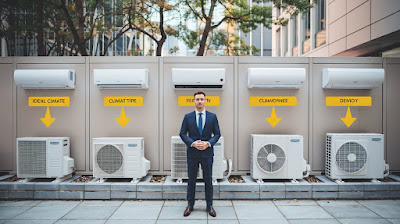Choosing the ideal air conditioner for your home or business goes beyond evaluating the equipment's capacity in BTUs. Each region has its own specific climate characteristics, which directly influence the type of air conditioner that is best suited to provide comfort and energy efficiency. From hot and humid climates to places with large temperature variations, it is possible to select the technology that best adapts to each condition.
1. Hot and Humid Climates
For regions with high temperatures and high humidity, such as the coast, it is important to choose devices with dehumidification functions. The split model is highly recommended, especially those with the "dry" function (or dehumidification), as they help to reduce air humidity, in addition to cooling the environment. Equipment with inverter technology is also advantageous, as it maintains a stable temperature, avoiding energy variations and offering greater efficiency.
2. Hot and Dry Climates
In places with high temperatures and low humidity, such as inland areas and arid regions, thermal comfort is best achieved with devices that have the option of ventilation and cooling. Air conditioning models that also have air conditioning functions can help improve air quality, since they add humidity to the environment. This type of system is an interesting choice for those seeking comfort in dry climates and want to avoid the discomfort of very dry air.
3. Climates with Great Temperature Variation
For places where there is a large variation in temperature throughout the day, hot and cold air conditioning models (also called reversible) are the most suitable. They allow the device to work both to cool and to heat the environment, providing comfort at any time of the year. It is especially useful for regions with well-defined seasons or in places that can have cold nights and hot days, offering versatility and savings with a single device.
Conclusion
Choosing the right air conditioning considering the climate is essential to ensure comfort and energy efficiency. Each type of climate requires specific characteristics, and with current technology, it is possible to find equipment that offers solutions for different environmental conditions. With a well-planned choice, the investment will be reflected in well-being, durability of the device and energy savings over time, adapting better to the conditions of each region.
